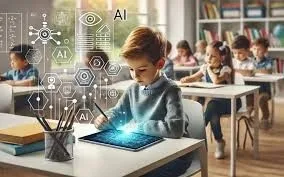Can AI Bridge the Global Education Divide?

Recently, AI has changed how we think about education. Many people hope that AI can make learning available to everyone and help solve the education gap around the world. But while AI has a lot of promise for helping poorer areas, it’s not that simple. We also need to think about how to get the technology and know how to use it. So, this makes us wonder: Can AI really help fix the education gap around the world?
The Promise: AI as an Equalizer
AI in education could help because it can make things easier for people to get. Many areas don’t have good education because they don’t have enough teachers, don’t have enough supplies, and it is hard for people to understand others. But with AI, we can find new ways to get education to more people in those areas. With things like tools to help people learn, and tools that can translate what other people say, AI could help poor areas by giving students access to materials and lessons that they can use themselves.
For example, AI can see how students are doing and change lessons to give them more practice and easier ways to learn if they are having trouble, so the student doesn’t have to go at the same pace as the rest of the class. And for areas where the people don’t speak the normal language, translation tools could help students understand lessons. This type of technology is already being used in some places, so we know that AI is a good way to make education cheap and easy to get.
The Reality Check: Persistent Barriers
However, not everything about using AI in education is good. AI can’t solve all the problems poor areas have. One big problem is that it’s hard for people to use AI in these places. If we want people in these places to use AI, they have to have access to the Internet, electricity, and devices that work every day. Many people in Africa, Latin America, and parts of Asia don’t have all of these things. So, AI is almost useless for them without all of these things.
Also, it’s hard to get people to use AI in education because teachers have to know how to use it. We can give teachers in poor areas in Africa an AI tool, but it won’t help if the teachers don’t know how to use it.
The Role of AI Tools in Education
Even though we mentioned some problems earlier, AI can still change education for the better. There are many AI-powered tools already out there. They are being used in different places and help address some challenges in countries that don’t have enough resources. These types of tools usually support both students and teachers. They try to make up for gaps because of differences in infrastructure and challenges like poor teacher training. These tools will not solve all the problems. However, they are a good first step in making learning easier to get and more personal for students everywhere. Here are a few examples:
1.AI Humanizers (e.g. GPTHumanizer):
These types of tools can help to polish AI-generated materials for improved readability. For example: A student can use AI to write a paper or generate answers for an assignment. They can then use an AI humanizer to understand the AI-generated text better and improve it so it is easier to read and understand.
2.Real-time Translation Tools:
AI translation tools (e.g. Google translate, or other student-enabling apps) can help bridge the language gap by translating textbooks, instructions, and online learning content in real time.
3.AI-powered Virtual Classrooms:
AI-powered Virtual Classrooms, such as Classroom.ai or other AI-powered virtual classroom platforms can help remote students take classes in real time without needing to be in a physical classroom. These platforms can track student progress, manage student participation, and even assign lesson plans to students based on the way an individual student learns.
What Needs to Happen to Realize AI’s Potential
In order for AI to work at its greatest potential, the stars have to align. Here are the 5 things that all need to line-up for AI to work, in the way we want it to, in education:
- Infrastructure and Access: AI relies on solid infrastructure like devices, internet access, and electricity, which are still woefully lacking in many regions.
- Teacher Training and Digital Literacy: Even if the AI works perfectly, teachers need to be trained to use the AI tools, and students need to be digitally literate themselves in order to take advantage of the offerings.
- Localization and Relevance: The AI needs to be localized to the language and cultural context of the people using it.
- Ethical and Inclusive Governance: AI in education needs ironclad ethical guardrails to ensure against further bias of marginalized communities. AI tools should help marginalized communities, not harm them further.
- Public-private partnerships: Government, NGOs, Tech companies and local communities need to work together to ensure responsible and sustainable AI use.
Conclusion
Can AI help bridge the global education gap? In theory, yes. It can help underserved students and supplement teacher resources by providing personalized learning and content. It is not an automatic solution. The key to AI’s success is to ensure that it is implemented responsibly, the infrastructure is there to support it and it must be aligned with local needs of the communities it was designed to serve. AI can be a bridge; it just needs to be built, very, very carefully.
